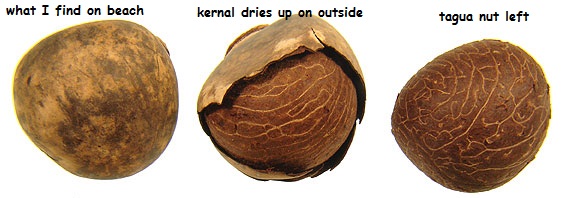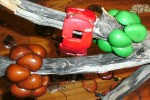This week I have an incredible assortment of tagua nut jewelry coming in from Ecuador. This jewelry is exquisite and when I found it in my travels and learned a little more about it, I knew it would be perfect for my customers! I find these little seeds on the beach when diving and walking a lot here in Florida. The seeds which have inner cavities are very buoyant and get washed down to the Atlantic where they end up on the beaches here in Florida. Never really knew what they were till I found this jewelry! I have 4 I picked up from my last dive in LBTS, just picked them up because I thought I could plant them.
Tagua Nut
Tagua nut is also know as vegetable ivory. This is because the color, appearance and feel of an aged tague nut is like ivory. Now we all know that it is ILLEGAL to import and sell ivory so in my opinion this is a fabulous way to get the same look without condoning the killing of elephants. The endosperm (seed) istraded as vegetable ivory, palm ivory, corozo or tagua. When dried out, it can be carved just like elephant ivory. The seed comes from a plant that looks similar to a palm. It’s scientific name is Phytelephas Aequatorialis Macrocarpa.
Tagua grows in the tropical rainforests of some South American countries, mainly Ecuador, Colombia and Venezuela, being Ecuador the country that fulfills most of the world’s demand.
Ecuador is one of the best places to see the trees, near the Napo River. This river is a major tributary into the amazon. The tree grows on under large rain forest trees along the streams and hillsides. Large pinnate leaves up to 20 feet tall rise from the trunk. Just like humans, they have male and female species. The female ones are where the seeds come from. They bear large fruit the size of melons or grapefruit. Each fruit has studded horns and will contain four or more of the tagua seeds. The fruit of the tagua tree is almost completely round measuring 20 to 50 cm in diameter with a blackish exterior. This fruit, also known as “mococha”, has many locular cavities each containing two or more seeds. The content of the immature fruit is a tasteless crystalline liquid. When it starts to ripen this turns into a sweet and pleasant milky substance, transforming later to a gelatinous viscous consistency and finally becoming an extraordinarily hard product similar in color, appearance and feel to natural ivory. The seeds are super hard and require a hacksaw to cut into one.
Tagua will take approximately 15 years to produce its first harvest and will not stop bearing fruit for all of the years and even a century to come. A 35 to 40 year old plant measures about 6 feet and produces, in the 3 yearly harvests, between 15 to 16 heads or “mocochas”.
Not only are the seeds of the tagua are used to elaborate buttons, figurines, beads, chess sets, napkin rings, cane and umbrella holders, door knobs, etc. but the roots are said to contain medicinal properties. The leafs are also used for hut roofing and the very fine dust from the “ojalillos” serve as a mix in cattle feed due to its high content of energy.
Another important factor to consider is that it provides work to thousands of people in these poor South American countries giving them and their families a better life and the opportunity of offering their children a better education. Vegetable ivory furthers important environmental and socioeconomic goals by stimulating the local economies , provides an alternative to cutting do wn rainforests for farming, and prevents elephants from being killed for the ivory in their tusks. n their native range, these palms are also used as a source of food and construction wood. Again, in my opinion all three are a vital alternative to what we are doing to our planet by depleting natural resources that can’t be quickly and efficiently replaced. The tagua nut is a sustainable and renewable source. A sustainable material is one that meets the needs of the present population without compromising the ability of future generations to meet their own needs. It is eco-friendly jewelry. Cultural Survival, an environmental group has stated that natural rain forest products like the tagua nut can generate up to five times the income of cattle ranches and banana plantations that they are clearing to rain forest to make room for.
wn rainforests for farming, and prevents elephants from being killed for the ivory in their tusks. n their native range, these palms are also used as a source of food and construction wood. Again, in my opinion all three are a vital alternative to what we are doing to our planet by depleting natural resources that can’t be quickly and efficiently replaced. The tagua nut is a sustainable and renewable source. A sustainable material is one that meets the needs of the present population without compromising the ability of future generations to meet their own needs. It is eco-friendly jewelry. Cultural Survival, an environmental group has stated that natural rain forest products like the tagua nut can generate up to five times the income of cattle ranches and banana plantations that they are clearing to rain forest to make room for.
How do these seeds become jewelry? Well, take a trip with me, First the kernels are typically simply picked up from the ground after the ripe fruit has detached from the tree and forest animals have taken care of the pericarp (outer brown husk) or harvested when ripe and the pericarp manually removed. Have a look at the picture to the left. As the nut shrinks when it hardens a small hollow cavity can form in the center. It is often not possible to know whether the inside of the nut will have a small cavity in the center until it is cut into. Therefore, when carving, it is common to either incorporate the hole or cavity into carvings or not carve deep enough to reach a potential cavity. Each tree will contain several cabezas (seed pods). The artisan will polish, sometime cut and sometimes dye each seed kernel into a work of art. No two pieces I carry are alike. Each one is unique and individual. Also, like ivory, worn over time, it can pick up body oils and have a nice creamy luster to it. The tagua nut contains natural swirls of color, rendering every slice totally unique.
So, again as you can see, I am super excited about this. Here is a sneak peak. Oh yeah, I forgot to mention the price, sets of necklaces, bracelets and earrings will retail under $60! For all 3 pieces…a fraction of what big designer houses are charging. Andean collection sold in Chico’s charges like $26 for a bracelet alone! I will have them for under $20.





















